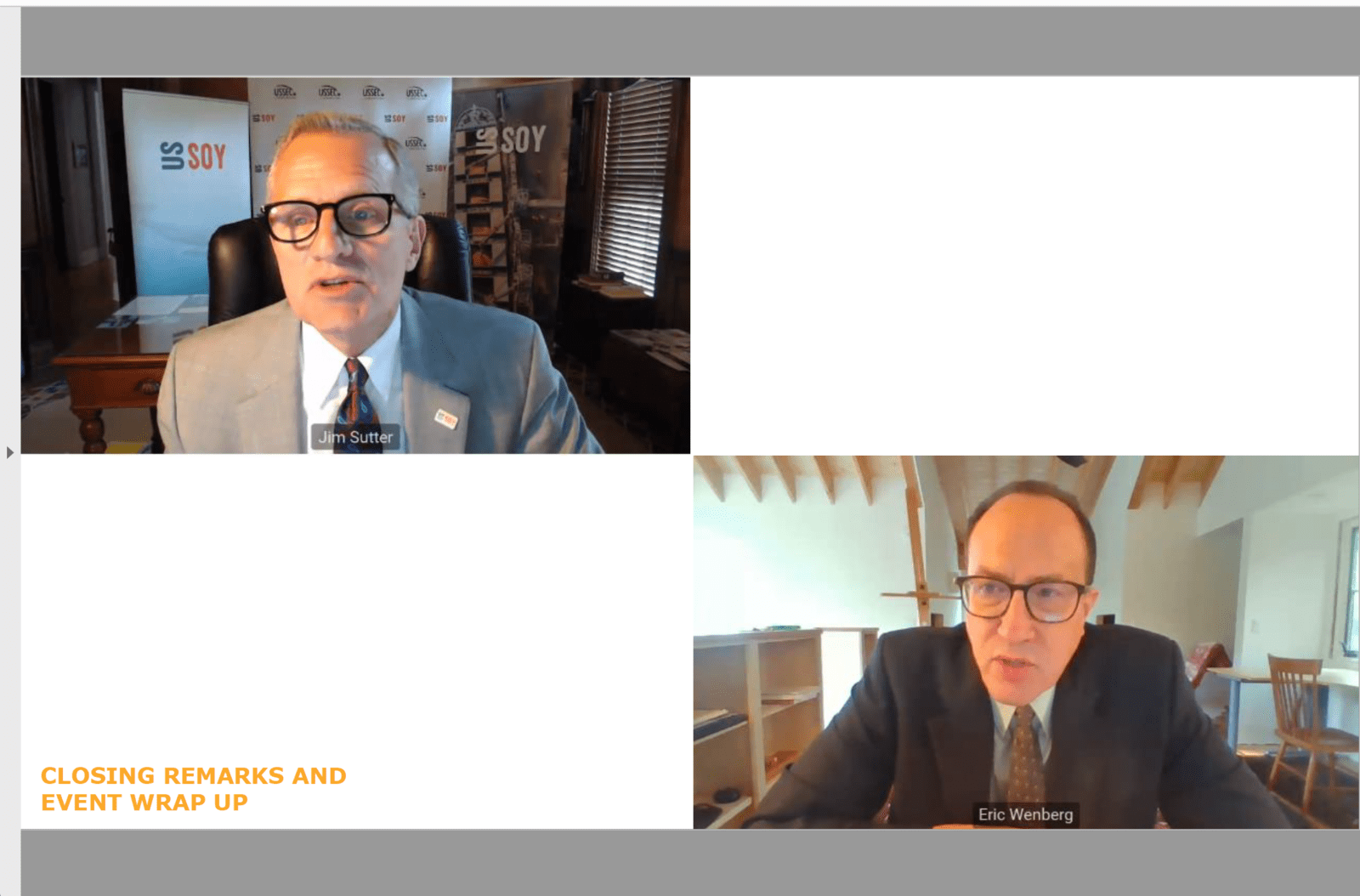Taking Stock: 2020 U.S. Soy Global Trade Exchange & Specialty Grains Conference
- Category:
- General News
- Virtual Events

In 2020, the U.S. Soy Global Trade Exchange & Specialty Grains Conference (GTE) went virtual for the first time, as the U.S. soy industry continued to work to connect with customers and key audiences during the COVID-19 pandemic. The U.S. Soybean Export Council (USSEC) and the Specialty Soya and Grains Alliance (SSGA) co-hosted 1,000 global customers and soybean industry representatives from 69 countries from August 24-27.
USSEC CEO Jim Sutter and SSGA Executive Director Eric Wenberg took a look back at the conference and shared some of their takeaways.
What did you learn from GTE?
Jim Sutter: That there is a great interest among global consumers of U.S. Soy to learn more and that while virtual meetings are something new and not what we are historically used to, they allow us to get important information to lots of people in a timely and cost efficient manner for both the participants and for USSEC. We had three times the international participants at the 2020 virtual GTE as we did at our largest previous event in 2019 in Chicago.
Eric Wenberg: Wow, did we have the conference the right week, with breaking news on trade and supply shifts. It’s a reminder you have to pay attention.
What surprised you the most?
JS: The level of engagement from key participants and their interest in chatting (virtually) during the trade show. While chatting, I was surprised to hear so many talking about sustainability and asking questions about this related to U.S. Soy’s practices and their ability to verify sustainable soy coming from the U.S. – my conclusion was that the global pandemic is heightening global consumers’ interest in where their food is coming from, how it is grown, etc. This is a good thing for U.S. Soy as we have a great track record!
EW: My experience with the GTE has been as a U.S. participant at the show site. You meet wonderful people from all over the world who are drawn together to discuss U.S. Soy and specialty grains. The surprise for me was that, doing the GTE virtually, I maybe saw the global map more clearly. Stepping back, I saw the really diverse population we need to reach throughout the world. Though I have decades of experience working in agriculture at home in the United States and abroad, it was a reminder just how many countries and diverse peoples we touch who are interested in buying from the United States.
What are your key takeaways?
JS: First, these sorts of virtual events work, and they should be a part of the tools we use to reach USSEC’s global partners in the future. Second, whether virtual or live – having good, interesting, timely content that can be presented in a concise, interesting manner so we respect the time of our participants is critical. And third, virtual trade show technology has improved and I’m optimistic that it will continue to do so. I’m already wondering what sort of global chat sessions or forums we could regularly provide so that the GTE type gathering is not just a once a year thing. That is something for us to explore!
EW: I am continually impressed by our farmer representatives and members. What a huge resource for the United States. And what a trusted group of quality products the foreign buyer can trust to deliver excellence. People abroad have often asked me what the key was to the United States’ success in farming, and I always answer: education. It comes through in the intelligence, passion, and devotion of our farmers to connect with the greater world. Our farmer presenters and leaders at the conference showed their sharp business minds and grasp of agricultural production practices, as well as a diplomat’s ability to connect with people.
Based on what you learned from GTE, what is your organization’s direction for the future?
JS: USSEC’s direction for the future won’t change – we will continue to collaborate with the industry as USSEC promotes the U.S. Soy Advantage, which includes our high-quality, nutritional bundle, sustainable production practices, and the reliability of the U.S. Soy export supply chain from farm to dock. We are also working to continue to ensure that USSEC is working to create a large, diverse customer base for U.S. Soy, which includes current markets but also emphasizes development in new, emerging markets that will be important in the future.
By conducting events like the GTE, we continue to learn new ways to reach customers of U.S. Soy and provide contact points with the great U.S. soy industry starting at the farm and going across the supply chain. Events like this teach us new tactics to roll out our strategies.
We do learn of some new points of heightened interest such as the point I made about sustainability above or the growing interest we are seeing in the Nutrition Value Calculator (NVC), which really helps people around the world to harness technology to turn a lot of complicated numbers into a simple dollars-and-cents model for their business.
EW: SSGA will be working on its core message about the high quality of U.S. field crops purchased through the identity-preserved system. Companies use the IP system to assure their customers that they’re receiving the high-value, premium crops that they ordered. That shone through in the breakout sessions we operated. We want foreign and domestic customers to see the full stretch of our agricultural system. And, at the top end, we’re showing that the premium paid for segregated, containerized IP crops comes through in returns at the end in foods and other manufactured products.
What else do you want participants and stakeholders to know?
JS: The COVID-19 pandemic has reminded us of our interconnectedness, and we want to help make those connections strong and secure. The folks at the GTE and in the global industries we work with should all be congratulated for keeping the world’s population fed with high quality, nutritious food throughout the challenging times we have seen – moving U.S. Soy from farms to export locations and then on to foreign countries where it is a critical raw material for food production systems all the way from animal and aquaculture production through to tempe and tofu production. It really is amazing!
EW: The GTE is special, as shows go. It’s our annual gathering, and we hope people will stay in touch and get involved next year too. SSGA is very pleased with its role helping USSEC with the show, and it’s our most-valuable partnership. We rely on USSEC each day and value the group and its contributions.
